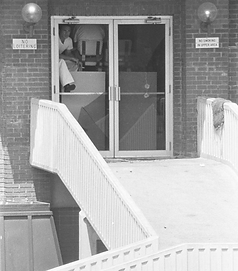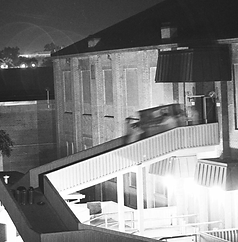
Huntsville Unit (Walls) Prison Hostage Siege
The Texas Prison Museum held a program July 27, 2024, commemorating the 50th Anniversary of the tragic Huntsville Unit (Walls) Prison Hostage Siege that began at approximately 1:00 p.m. on July 24, 1974 and lasted 11 days ending on August 3, 1974. This incident has been referenced in years gone bye as "The 11 Days in Hell." Below are some photos taken during the siege. At the conclusion of this page is a video recording of the panel discussion held July 27, 2024 to help remember the employees lost in the siege, honor the surviving family members of the victims in the siege and honor those employees who put their lives on the line to put this horrific event to a conclusion.
11 Days in Hell:
50th Anniversary of Hostage Siege at the Huntsville Prison
By Robert Riggs
Huntsville, Texas - 50 years ago, Huntsville, Texas became the center of national attention as a tense prison hostage crisis unfolded inside its first state prison known as “The Walls Unit.” For 11 days behind its 15-foot redbrick wall in the sweltering summer of 1974, three armed inmates held 15 people hostage, culminating in a violent shootout that left two hostages and two inmates dead.
The longest prison siege in American history started at 1 p.m. Wednesday, July 24, 1974, inside the unit’s education building. Frederico “Fred” Gomez Carrasco, a 34-year-old notorious drug lord serving a life sentence for the attempted murder of a San Antonio policeman, and two other armed inmates stormed the third-floor prison library.
Fred Carrasco, infamously dubbed the “Mexican Connection” by law enforcement, was a notorious and formidable drug kingpin who ruled a vast cocaine and heroin empire spanning from San Diego to Chicago. Born and raised in San Antonio, Carrasco embarked on his criminal journey at 15. By the late 1960s, he had ascended to the pinnacle of his illicit career. Operating from Nuevo Laredo, Texas, Carrasco maneuvered seamlessly across the United States and Mexico, largely undeterred by authorities.
Carrasco’s ruthless reputation was immortalized in Spanish ballads, celebrated in local dance halls, and feared by many. His tales of violence and audacity, including his boastful claim of having gunned down forty-seven men, earned him the fearsome moniker “El Senor” (The Man). His legend, marked by gun-slinging bravado and a chilling body count, cemented his status as one of Texas’s most feared and deadly figures in the drug trade.
Aiding him were 42-year-old Rudolfo Dominguez, described by the prison priest as a “vicious man” who believed in nothing. During the ordeal, the hostages’ believed Dominguez was the hostage most likely to harm them. Also aiding Carrasco was a Mexican Nationalist Ignacio Cuevas who was known to be below an average inmates average I.Q.
As news of the siege spread, Huntsville transformed into a media circus. Reporters from across the country descended on the small town, broadcasting live updates and speculating on the fate of the hostages. The crisis became a national spectacle, with millions of Americans following the drama as it unfolded.
Inside the library, the situation was tense and unpredictable. James Estelle Jr., the Director of the Texas Department of Corrections (TDC), engaged in marathon negotiations and used stalling tactics with Carrasco. The mercurial psychopath repeatedly threatened to shoot or blow up the hostages if Estelle did not meet his demands. Dominguez and Cuevas tormented the hostages by brandishing guns at their heads.
Some of the hostages apparently succumbed to the Stockholm Syndrome, in which hostages develop positive feelings toward their captors. As the days wore on, Carrasco manipulated the hostages and their families, who sharply criticized TDC during interviews with reporters to influence public opinion. Ed Rabel of CBS News refused to participate, raising concerns that the press was being used.
During the takeover, Carrasco released four hostages at different intervals, including the prison’s director of education, who suffered a heart attack, and a librarian who faked a heart attack. An inmate hostage, desperate to avoid implication, escaped by diving through a plate glass door.
Meanwhile, Warden Howell Husbands had to maintain order among the prison’s 1,900 inmates. The dining hall was below the library, and the slightest sounds would set off the paranoid hostage takers. Husbands had to lock down the unit and serve sandwiches in paper bags to the cells.
It became clear to Estelle and FBI agent Bob Wiatt that Carrasco did not have a well-thought-out escape plan. They surrounded the prison and Huntsville with a security blanket to thwart any attempt by Carrasco’s gang to make his getaway.
Among the hostages was Ann Flemming a 50-year-old librarian, who had been working at the prison for just 20 days when Carrasco fired a single round into the ceiling from a .357 caliber revolver. Carrasco shouted, “Stop right there, or I will kill you!” Flemming recalled her experience during an interview 20 years ago. “The thing that really amazed me,” she said, “was how everyone – men, women, guards – was terrorized. I was terrorized. I was afraid. I realized that there was no way out.”
The trio hostage takers had enlisted a trustee to smuggle weapons and ammunition into the formidable red-brick prison that dominates downtown Huntsville. A .38 caliber revolver entered inside a hollowed-out ham, two .357 caliber revolvers passed by guards concealed in meat packages, and the bullets came in an institutional-size can of peaches.
Carrasco quickly released 56 inmates and took 11 employee hostages, consisting of seven women and four men, plus and additional four inmates. Prison Chaplain Father Joseph O’Brien later volunteered to replace a hostage. The hostage-takers demanded weapons, bulletproof vests, and an armored car for their getaway. They also insisted on safe passage to Cuba, which put state officials in a difficult position. Texas Department of Corrections policy strictly forbade the release of prisoners in exchange for hostages, setting the stage for a prolonged standoff.
The Huntsville Item published its first extra since World War II, knocking President Richard Nixon’s Watergate Scandal off its front page.
Carrasco demanded expensive men’s apparel to replace their white inmate uniforms, bulletproof vests, helmets, walky-talkies, and weapons. Estelle provided $1,300 worth of suits and dress shoes, plus Gerry rigged steel headgear that resembled welder’s masks, which are displayed at the Texas Prison Museum.
The inmates built a makeshift “Trojan Horse” to escape to a waiting armored truck. They taped together rolling six-by-six chalkboards fortified with 700 pounds of library law books wrapped around the outside as a shield. Carrasco and his two henchmen took cover in the three-foot space between the chalkboards. They handcuffed themselves to four hostages who volunteered to get inside the contraption: librarian July Standley; teacher Von Beseda; prison school principal Novella Pollard; and Chaplain Father Joseph O’Brien. The eight other hostages on the outside maneuvered the Trojan Horse, also called a “Trojan Taco”, down a winding ramp. Prison Director Estelle had no intention of letting them reach the armored truck.
The rickey shield jammed against the rail on the last right-angle turn of the four-turn ramp where officers hid to ambush them. Guards blasted the Trojan Horse with water from three high-pressure hoses. The plan to knock it over went awry when a hose burst. As soon as the first water blast hit the shield, Carrasco pumped a deadly hollow point round into Von Beseda’s heart. Dominguez fired three deadly rounds into Judy Standley’s back. Another bullet splintered Father O’Brien’s left arm and lodged fragments near his heart. Inmate Cuevas passed out and fell, taking Pollard down with him to safety.
Gunfire erupted from inside the Trojan Horse through gun ports Carrasco and his accomplices had cut in the Chalkboards. A 22-minute gun battle ensued. FBI agent Bob Wiatt took two rounds in the chest of his bullet-resistant vest. Texas Ranger Captains James (Pete) Rogers and G.W. Burks also took hits in their vest. The three officers quickly recovered and rejoined the fight.
When firefighters outside the prison restored water pressure and blasted the Trojan Horse again, Carrasco shot himself in the head. Officers used a ladder as a battering ram to topple the shield. Dominguez was lying under Father O'Brien with the barrel of his gun stuck in his back. When the Chaplain rolled over, officers put two deadly rounds into Dominguez’s head and one in his neck. The last shots were fired at 9:50 p.m., ending the 11-day siege on the moonlit night of August 3, 1974.
Seventeen years later, Ignacio Cuevas was put to death by lethal injection inside the Walls Unit, where he had taken part in the murders of Von Beseda and Judy Standley. The San Antonio police officers who were in the shootout that had sent Carrasco to the Walls Unit later said, “We should have killed him when we had the chance.”
The Texas Prison Museum will commemorate the 50th anniversary of the historic July 24, 1974, hostage siege at the Huntsville Prison Unit, one of the longest in United States history. To honor this significant event, the museum will host a panel featuring individuals from various agencies involved in the 11-day standoff.
Robert Riggs, creator of the True Crime Reporter podcast and Executive Producer of “Freed To Kill,” the award-winning TV documentary about how serial killer Kenneth McDuff was released under a cloud of corruption, will moderate two sessions at 10 a.m. and 2. p.m. Saturday, July 27, 2024, accommodating community participation. The event will take place at the Texas Prison Museum, located at 491 State Highway 75 North. For more information and to reserve seating, call the Texas Prison Museum at (936) 295-2155.



Inmate Carasco, Fred Gomez
Command Center - Director Estelle on phone
Correctional Officers outside "Walls Unit" at conclusion of siege.

Father Joseph O'Brien at Huntsville Unit Bullring

Inmate Hostage Ordered to Perform Look Out Duty by Hostage Takers.

TDC Assault Team Members On Stand By During Initials Days of Siege.


Assault Team Members living quarters during siege.
Governor Dolph Briscoe Interviewed During Initials Days of Siege in Austin, Texas.

Sandbags placed on outer back Education Wall to enhance impact of explosives that were to be used to gain entrance to Education Building.



Officials Initial Look at What the Trojan Horse Looked Like.
Hostages (Employees and Inmates) Tethered to Trojan Horse Guiding It Down the Ramp to Armored Vehicle
Beginning Stage of the Assault on the Trojan Horse by Texas Ranger, FBI and TDC Assault Team Members.



TDC Correctional Officers Taking Injured Employee Hostages From Ramp to "Walls" Hospital
A Photo of the Education Building Where Hostage Takers Held Hostages for 11 Days.
Photo of Trojan Horse After Siege Conclusion.


Director W. J. "Jim" Estelle Addressing Media at Conclusion of Hostage Siege.
Video Recording of Panel Discussion Held in Cameration of 50th Anniversary of Hostage Siege. Panel Members are: (L to R) Retired Texas Ranger Maurice Cook; Retired Texas Ranger Joe Davis; Retired American Statesmen Journalist Mike Cox; Retired American Statesmen Journalist Wayne Jackson; Bruce Noviskie TDC Sergeant Shot in Foot at beginning of Siege; Retired TDC Regional Director Kent Ramsey; Retired TDC Director of Classification S. O. Woods; Retired Classifications Manager Ben Aguilar; Retired TDCJ Executive Director Wayne Scott.
